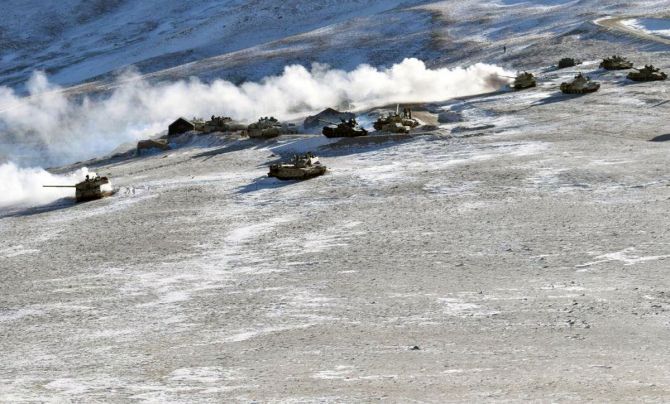It has been argued that India should have held back on disengagement from the Kailash Range, using that as a trump card to force Chinese concessions in areas such as Depsang, where they hold the advantage.
Ajai Shukla reports.

Lashing out at 'misinformed and misleading comments' regarding the disengagement currently underway at Pangong Tso, the defence ministry issued a written statement on Friday, explaining precise details of the disengagement plan hammered out by senior military officers from India and China.
The ministry's five-point statement was issued just hours after Congress MP Rahul Gandhi alleged that Prime Minister Narendra Modi had 'ceded' Indian territory in Ladakh to the Chinese.
This is the first time during the ongoing crisis that the government has officially and publicly clarified details relating to deployment or disengagement.
Pointing out that Defence Minister Rajnath Singh had already communicated the factual position to Parliament, the ministry said it was nevertheless necessary 'to set the record straight and counter certain instances of wrongly understood information being amplified in media and social media.'
First, the ministry's statement made the academic, but important, point that India's territorial claim extended well beyond Pangong Tso, and that our claimed border with China was distinct from the Line of Actual Control, which was the result of Chinese aggression in 1962. India continues to exercise that claim.
'The assertion that Indian territory is up to Finger 4 is categorically false. The territory of India is as depicted by the map of India, and includes more than 43,000 square kilometres currently under illegal occupation of China since 1962,' the ministry stated.
Second, the ministry dealt with the alignment of the LAC, rejecting news reports that said it ran through Finger 4 to the Pangong Tso lake.
Indian troops have always patrolled up to Finger 8 and the ministry clearly stated that it continued to assert that claim.
'Even the Line of Actual Control, as per the Indian perception, is at Finger 8, not at Finger 4. That is why India has persistently maintained the right to patrol up to Finger 8, including in the current understanding with China,' the ministry stated.
Third, the ministry made the distinction between 'permanent posts' of India and China, in which troops were stationed for significant periods; and 'forward deployments', which were closer to the LAC and where patrols would camp for perhaps a night or two.
The agreement allowed troops from both sides to continue occupying their 'permanent posts' north of Pangong Tso, but not to proceed any closer to the LAC.
'Permanent posts of both sides at the north bank of Pangong Tso are longstanding and well-established. On the Indian side, it is Dhan Singh Thapa Post near Finger 3 and on the Chinese side, east of Finger 8. The current agreement provides for cessation of forward deployment by both sides and continued deployment at these permanent posts,' the ministry stated.
Fourth, the ministry statement addressed accusations from the Opposition that Indian troops had been barred from entering their own territory.
'India has not conceded any territory as a result of this agreement. On the contrary, it has enforced observance and respect for LAC and prevented any unilateral change in the status quo,' the ministry statement said.
Fifth, and finally, the ministry rebutted accusations that it had made a deal with China in Pangong Tso, but ignored the far more worrying Chinese incursions in the Depsang sector; and in Gogra and Hot Springs.
'Raksha Mantri's statement also made clear that there are outstanding problems to be addressed, including at Hot Springs, Gogra, and Depsang. The outstanding issues are to be taken up within 48 hours of the completion of the Pangong Tso disengagement,' the ministry said.
It is not clear whether the Chinese would respond after India took up the issues of Depsang, Gogra, and Hot Springs. So far, the Chinese negotiators have refused to discuss those.
The ministry statement was silent on why it had agreed to disengagement in the South Bank of the Pangong Tso, where Indian troops held dominating heights on the Kailash Range and, consequently, held a tactical advantage over the Chinese posts nearby.
It has been argued that India should have held back on disengagement from the Kailash Range, using that as a trump card to force Chinese concessions in areas such as Depsang, where they hold the advantage.
Finally, the ministry statement played the 'nationalism card', accusing those who questioned the disengagement plan of 'disrespecting' the sacrifice of our brave soldiers.
'The effective safeguarding of our national interest and territory in the Eastern Ladakh sector has taken place because the government has reposed full faith in the capabilities of the armed forces,' the ministry stated.
'Those who doubt the achievements made possible by the sacrifices of our military personnel are actually disrespecting them.'











